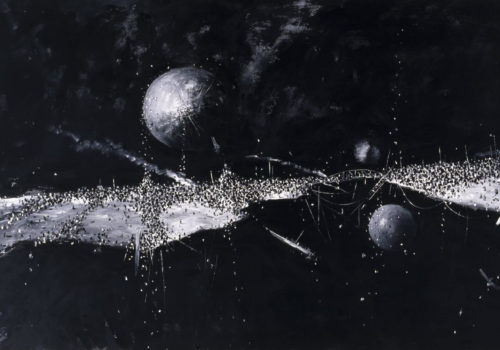The ‘Russian Cosmos’ exhibition project organised as part of the Year of Italian Culture in Russia and Russian Culture in Italy has been timed to coincide with the 50th anniversary of man’s first space flight.
This is a unique attempt to analyse the connection between ideas of the cosmos established by Russian philosophers, scientists, writers and artists in the early 20th century and contemporary Russian art. It is no coincidence that historical prerequisites for the emergence of Cosmism in Russia appeared in the late 19th century. A combination of harsh climatic conditions for life, the constant geographic struggle against internal and external foes and the religious belief of the Russian people in a future paradise led to notions of Cosmism and the conquest of cosmic space.
The founder of Cosmism was religious philosopher Nikolai Fyodorov (1829 – 1903), who devised a theory about the resurrection of the dead. Cosmism became an important utopian concept in Russia, where the idea was adopted with revolutionary fervour and a desire to change the world. Fyodorov’s doctrine was endorsed by Tsiolkovsky, the poet Velimir Khlebnikov and founder of the new avant-garde Suprematism movement Kazimir Malevich. The combination of new ideas in culture and science produced grandiose consequences. A revolutionary perestroika peculiar to Russia was set in motion, and the results of this reorientation deeply influenced future generations. Moreover, ideas of Cosmism were to some degree realised: the USSR was the first world power to launch a sputnik in space, and in 1961 Yuri Gagarin became the first man in space – after which every Soviet child dreamed of becoming a cosmonaut one day. The theme of Cosmism and the cosmos featured in the work of Russian artists throughout the 20th century. The Russian Cosmos’ project presents works by great artists of the Russian avant-garde such as Kazimir Malevich, Alexander Rodchenko, Chashnik, Suetin, Sterligov and Chekrygin, along with drawings and objects created by Konstantin Tsiolkovsky. The project also includes work by stars of Russian contemporary art Ilya and Emilia Kabakov, Francisco Infante, Dmitry Gutov, Sergei Shutov, Konstantin Batynkov, Yuri Avvakumov and Alyona Kirtsova, Pavel Pepperstein, and young artists Ivan Mikhailov and Margo Trushina.
The exhibition is divided into six sections. The first is dedicated to Nikolai Fyodorov (1829 – 1903), the great religious philosopher and leading proponent of resurrection after death. Fyodorov also developed ideas of cosmic resettlement and the union of past and future generations. Fyodorov’s ideology exerted enormous influence on 20th-century philosophers and thinkers. Books with Italian translations of Fyodorov’s doctrines will be displayed in this section beside works by contemporary artists. The second part of the exhibition is devoted to great Russian scientist Konstantin Tsiolkovsky (1857 – 1935), Fyodorov’s pupil and the founder of modern cosmonautics.
This will include a series of sketches by Tsiolkovsky and his model of a dirigible. The same exhibition room presents the Soviet science-fiction film ‘Cosmic Flight’ (1935), which employed Tsiolkovsky as scientific consultant, and the ‘Centre of Cosmic Energies’ model by Ilya and Emilia Kabakov. The third section focuses on Kazimir Malevich (1879 – 1935), whose work provided the theoretical basis for Suprematism, an art movement founded on the philosophical theories of Cosmism. The ear trumpet by which Konstantin Tsiolkovsky communicated with the outside world will also be exhibited here, beside drawings by Kazimir Malevich, Vladimir Sterligov and Nikolai Suetin. The fourth part of the exhibition is devoted to Sergei Korolyov, the Soviet scientist and designer who brought Konstantin Tsiolkovsky’s fundamental ideas to life. Despite the repression which led to Korolyov’s arrest in 1938 and subsequent imprisonment, the brilliant scientist continued to work on aircraft designs. The launches of an artificial satellite of the Earth and the first cosmonaut Yuri Gagarin were accomplished due to his ideas and organisational skills. The ‘Lunar Landing’ sketch Korolyov made at a scientific conference will be shown for the first time at the Turin exhibition.
The fifth part of the exhibition presents the work of Ivan Yefremov, author of the acclaimed science-fiction novel ‘Andromeda Nebula’, the cult classic about a Communist utopia set in the distant future. The novel has been republished many times in different languages, and a screen version was released in 1967. Finally, the sixth section is dedicated to Yuri Gagarin, the first man in space. His words ‘Man’s greatest strength is the strength of the spirit…’ became a slogan for many generations of Russians.
This exhibition is a multimedia installation divided among six cubic rooms that call to mind the structure of a space station. Within these rooms there is a never-ending dialogue between Russian philosophers, scholars and scientists of the late 19th to early 20th centuries, and artists of the early 21st century. Today the dirigible model and Konstantin Tsiolkovsky’s ear trumpet displayed in the exhibition halls of the Castello di Rivoli seem like fully-fledged objects of Actual Art, proof yet again that the idea of Cosmism is still very important in Russian art.
Le Cosmos Russe
Until February 20, 2012
Castello di Rivoli
Piazza Mafalda di Savoia
10098 Rivoli (Turin)
















